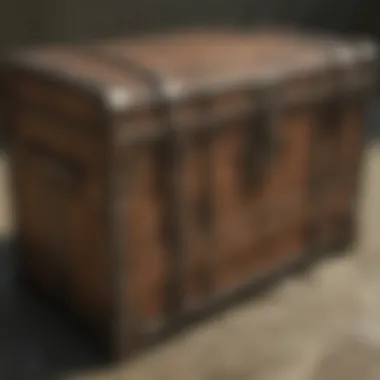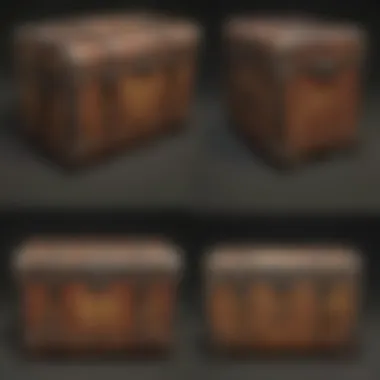Mastering Steamer Trunk Plans: A Complete Guide


Intro
Steamer trunks serve as both functional luggage and decorative pieces, rich in history and craftsmanship. As you embark on designing and building your own trunk, there are many intricacies to explore, from the wood and hardware options to the stylistic flourishes that reflect your personal taste. Understanding these elements will enhance both the process of creating your trunk and the final product itself.
The significance of planning cannot be overstated. The right designs and thoughtful craftsmanship result in a steamer trunk that works well over time. Whether you are a novice builder or a skilled craftsman, this guide will provide valuable insights into the realm of steamer trunk plans.
Understanding Steamer Trunks
Steamer trunks have a rich history and importance in both practical and aesthetic contexts. They serve not just as storage for travel but also as a fine piece of furniture and design. In understanding steamer trunks, one explores a unique blend of history, craftsmanship, and the opportunity for customization.
Knowing about steamer trunks enhances appreciation. Each trunk carries stories of voyages and the eras they represent. These trunks reflect the design trends and societal influences of their time, offering insights into various cultural and historical contexts. Furthermore, building your own trunk allows for a personalized approach. You define its dimensions, enhance its functionality, and make it a piece of art that resonates with your style.
Historical Context of Steamer Trunks
Steamer trunks have an interesting past that traces back to the 19th century when they were essential for long voyages, especially by sea. These trunks evolved from simple containers to elaborate storage solutions that accompanied passenger liners. During this time, travel became more common.
Many consider these trunks a status symbol. With increased travel amongst the elite, the design of trunks underwent significant change. Manufacturers began using quality materials. Unlike basic wooden boxes, steamer trunks included leather bindings, intricate locks, and aesthetic embellishments.
Design influences varied from region to region. For instance, European craftsmanship offered intricate detailing, while American-made trunks emphasized practicality. Furthermore, the decline of sea travel in the mid-20th century significantly changed the usefulness of these trunks. Appearances became a vital factor over functionality as tourism transformed.
Recognizing the past of steamer trunks not only aids in their design but adds depth and meaningful connections to the craft.
Functional Versus Aesthetic Design
When creating a steamer trunk, balancing functionality with aesthetics is crucial. Understanding this dichotomy allows builders to design trunks that are both practical and visually appealing.
Functional aspects include:
- Storage capacity: Define how much you need to carry.
- Durability: Use sturdy materials that withstand wear and something meant to last.
- Organization: Including compartments can greatly enhance ease of use.
On the aesthetic side, designing a trunk involves creativity and personal expression. Factors like color, texture, and style must relate to the intended environment.
Suggestions for incorporating aesthetics:
- Choose a thoughtful color palette that speaks to your taste.
- Incorporate artistic elements, like stencil art or patches, that add personality.
- Finishes play a key role; consider using varnishes that enhance the final piece.
By harmonizing both design elements, trunk builders can create a storage unit that not only meets functional needs but also serves as a striking visual element in any setting.
Designing Your Steamer Trunk
Designing a steamer trunk involves much more than mere aesthetics; it requires careful thought and planning to make sure form meets function. The design decisions you make will impact the overall usability of the trunk as well as its appeal. Whether you wish to store travel memorabilia or use it as an eye-catching statement piece in your living space, the design will define what you can achieve with it. Design choices can dictate capacity, durability, and convenience of transportation.
Key elements to consider during this phase include physical size, weight, structure, and material preparedness for the weather it might endure. Moreover, these aspects set the stage for attachment of functional components like handles, latches, and wheels if needed. An overly complex design can result in structural weakness or ineffective usability, confusing the intended purpose of the trunk.
When planning your trunk, prioritize a clear understanding of your intended functionalities. Effective design can enhance your project's end result and provide a valuable storage solution or decor item aligned with your aesthetic vision.
Choosing Dimensions and Capacity
The dimensions and capacity of a steamer trunk will largely determine its functional benefits. Consider carefully this aspect. The most common dimensions range, quite significantly depending on intended uses. Whether you lean towards storing seasonal clothing, linens, or considerable travel belongings influences size requirements.
It's essential to think about both the external and internal measurements. The outer dimensions must ensure that transporting the trunk is feasible while the inner capacity addresses what you want to store. Utilize a measuring tape to visualize physical space for the trunk to ascertain its compatibility in your desired location.
Additionally, be mindful of height. A lower trunk may sit better below windows or work as a coffee table, while a taller one dons to display vintage stickers or thematic craftsmanship. Consistently assess how dimensions tailor both visual elements and practical utilization.


Design Inspirations from Various Eras
History offers a treasure trove of design inspirations for steamer trunks. Each era presents a unique aesthetic characterized by the prevailing cultural circumstances and design philosophies of the time. From the intricacies of Victorian metal work to minimalist 20th-century breath, each style speaks to diverse craftsmanship skills. Assessing these various inputs can significantly consolidate vibrant ideas relevant to your steamer trunk.
- Victorian Era - Known for ornate details, this era encourages the use of rich woods and detailed decorations. Think about decorative brass accents or in-depth surface engravings.
- Art Deco - This period champions geometric shapes and bold colors. An Art Deco-inspired trunk could include several segmented compartments and contrasting material blends.
- Mid-century Modern - This focus leans towards functional solutions with straightforward structures and clean lines that maintain a focus on practicality whilst still sharing style.
Exploring the aesthetics from each era inspires not only designs but also attests to the adaptability and purpose implied with crafting the steamer trunk.
Sketching Your Trunk Plans
Transitioning from ideas to a solidified plan begins with sketching. Translating your vision into drawings serves as a fundamental initial step in understanding the proportions and design elements you previously decided on. Detailed sketches allow for reassessment of your design to predict challenging areas before execution is commenced.
Start with the layout of your trunk. Answer necessary conceptual questions like compartment design and the aesthetic features from the drafting phase. A more thorough approach consists of:
- Creating an overhead view
- Making rough side views to model orientation.
- Stipulating dimensions in scale
Proper sketching highlights potential structural flaws before they manifest in physical trials. This crucial representation saves significant time, money, and materials by honing a perfectly tuned design.Believe it or not, even remarks such as sizing for hinges or wanting a detachable lid should find their voice within your sketch. This visualization serves as an interaction points toward building your trunk properly.
This thoughtfully designed structure lays the foundation for a successful assembly phase, effectively addressing all aspects discussed in this section.
Materials for Construction
In the journey of building a steamer trunk, selecting materials is paramount. The choice of materials will define the trunk’s aesthetics, durability, and usability. Each component—wood, hardware, and finishing—plays a key role in both function and appearance. Understanding the importance of material selection helps builders create trunks that not only fulfill practical needs but also reflect personal style.
Selecting the Right Wood
Wood is the backbone of any steamer trunk. Its strength, weight, and appearance impact the trunk's overall quality. Common woods for trunk construction include plywood, oak, and birch. Plywood, for example, is cost-effective and lighter, making it suitable for larger projects. On the contrary, solid woods like oak provide durability and aesthetic appeal, even if they may come with a higher price tag.
Investing time in selecting the appropriate wood species ensures that the steamer trunk meets your desired longevity. Professionals often recommend choosing seasoned wood, as it reduces risks associated with warping over time. Another consideration is sourcing wood with minimal knots, ensuring fewer potential weak points in the structure.
Choosing Hardware and Accessories
Hardware is essential for both functionality and design of a steamer trunk. Components such as hinges, locks, and handles must not only support heavy use but also complement the trunk's visual appeal. Robust brass hardware is often favored for its resilience and classic look. However, stainless steel also emerges as a popular choice due to its corrosion resistance and modern aesthetic.
Accessories help elevate a trunk's functionality. These could include trays for organization, removable liners for cleanliness, and wheels for mobility. Choosing hardware based on intended use can enhance the overall performance of the trunk over time. Thus, a user should consider both visual aspects when selecting these critical elements.
Using Appropriate Finishing Products
The finish applied to a steamer trunk serves multiple purposes. It protects the wood from moisture and abrasion while also enhancing its natural beauty. Selecting the right finishing products is crucial. Options include varnish, oil, and lacquer. Each finish offers different attributes in terms of sheen, feel, and durability. For example, polyurethane might provide the most protection, making it ideal for highly-used trunks.
Care should be taken to avoid finishes that may emit strong fumes or contain harmful chemicals, especially when working in enclosed spaces. Additionally, proper application enhances the final look—sanding between coats, for instance, can yield an exceptionally smooth surface.
Key Consideration: Always test any finishing product on a scrap piece of wood first to gauge color and compatibility.
By focusing carefully on the materials used—wood, hardware, and finishing products—craftsmen can successfully build steamer trunks that balance both form and utility. Effective material selection guarantees that resulting trunks may carry not only sentimental value but last through the years.
Essential Tools and Techniques
In the art of building a steamer trunk, tools and techniques serve as the foundation of not only the construction but also the overall quality and integrity of the final product. Knowing which tools to use and how to effectively apply them can significantly impact both the outcome and efficiency of the trunk building process. It is essential to understand the unique requirements of the design, the materials chosen, and the desired durability of the finished product. Incorporating the right techniques during assembly ensures that the trunk will withstand the rigors of use, as well as time itself.
Required Tools for Trunk Building
The tools necessary for building a steamer trunk may vary based on the complexity of the design. However, there are certain fundamental tools almost every builder will need:


- Circular saw: This is vital for cutting wood sheets to specific dimensions. Precision is critical, as uneven cuts lead to gaps.
- Table saw: Excellent for making long, straight cuts with care.
- Drill: Essential for creating holes for connecting pieces and ensuring nails or screws are secured tightly.
- Screwdriver set: Needed to install various screws throughout the trunk.
- Clamps: These provide crucial holding power while glue dries and during assembly.
- Sander: Smooths all surfaces to give a polished look and prevents splinters.
- Measuring tape: Accurate measurements are necessary, as trunk integrity relies on precision.
- Square: Helps ensure angles are correct, which is particularly important in trunk corners.
Using quality tools results in better workmanship. It enables enthusiasts to fit components snugly together. Furthermore, new expect exceptional beauty and functionality.
Construction Techniques for Durability
Durability is one of the main concerns for anyone undertaking the construction of a steamer trunk. Various techniques can enhance resilience, ensuring the trunk is long-lasting. Consider the following approaches:
- Jointing Methods: Using dovetail joints can add strength to corners. This prevents the wood from separating over time, a frequent concern when heavy objects are stored.
- Reinforcement: Placing metal brackets inside at critical stress points can further increase durability. This is especially relevant for lids and corners.
- Use of Quality Screws and Nails: Cheap fasteners can rust or fail. Invest in good quality alternatives to enhance longevity.
- Proper Adhesive Selection: Using wood glue is also critical. It fills gaps better than screws alone and adds integrity when dried.
By employing such techniques, builders can create a steamer trunk built not just for aesthetics but also for resilience.
Finishing Touches and Personalization
The finishing touches are where a steamer trunk can truly reflect the owner's style while adding protection to the wood itself. Choices made during this stage significantly influence the final look and ensures that the trunk stands out.
- Staining and Painting: A dark stain can give an old-world charm, while bright colors can modernize the look. Each finish introduces a unique character reflecting personal taste.
- Hardware Selection: Handles, hinges, and locks add functionality. They also contribute to the trunk's overall aesthetic feel.
- Lining: Choosing fabric or vinyl for interior lining is essential. Not only does it offer a softer surface for belongings, but it can also appear as decorative accents once opened.
Consideration towards these finishing touches not only elevates decorative value but also improves practicality.
It's crucial to approach steamer trunk construction with a balanced view of aesthetics and functionality.
In summary, understanding tools and techniques paves the path for effectively executing fashionable snag-proof steamer trunks. Every build should highlight skillful craftsmanship while satisfying individual aesthetic preferences, resulting in not only a richly personal item but also functional and durable furniture.
Step-by-Step Building Process
The process of building a steamer trunk is not mere fabrication but an intricate dance of craftsmanship and precision. Through a step-by-step approach, one can not only create a visually appealing trunk but also ensure durability and functionality. This segment outlines the specific elements integral to the construction journey, emphasizing the benefits of systematic building methods which enhance overall outcomes.
The detailed steps provide a clear blueprint for both novice and experienced crafters. Emphasis on planning ensures that the builder’s vision translates effectively into reality, addressing critical considerations that arise during the construction process.
Creating the Base and Frame
The foundation of any steamer trunk is its base and frame. This structure determines the trunk's stability and support. Begin by selecting a sturdy wood type, such as pine or birch, due to their durability and ease to work with. Ensure the wood is free from knots; they can weaken the trunk.
Start by cutting the wood into the desired dimensions. Tips for accuracy include using a miter saw for straight cuts and measuring twice before each cut. Once cut, assemble the frame using wood glue and screws, making sure it is square and level.
Key Steps
- Measure and cut the wood for the base according to your trunk dimensions.
- Assemble the frame by joining the base with side pieces.
- Use clamps to hold pieces together while the glue dries.
Ensure that braces are place strategically to support loads and weight distributed uniformly. A strong base and well-constructed frame lay the groundwork for successful construction.
Assembling the Sides and Lid
With a solid frame established, the next step is to assemble the sides and lid. Usually, the ribs provide more form to the overall trunk. Materials like plywood or solid boards could be favorable according to the desired weight of the trunk.
Begin by cutting the side panels and lid to fit snugly within the frame. It is crucial that the panels are measured accurately to avoid any gaps that would compromise both aesthetics and function. Adamant use of wood glue and screws ensures a sturdy assembly.
Assembly Actions
- Affix side panels to either of the frame: Apply glue, clamp, and secure with screws.
- Suspend the lid with hinges, taking care to align it unlock to forming an even contour.
- Sand edges for periodic consistency when finished.p>
Lid creativity can play a major role in finishing your trunk. Harsh angles or scalloped edges can define your style loud and clear.


Installing Hardware and Lining
The last construction stage involves installing hardware and lining the interior, essential for enhancing both aesthetic and practicality. Selection of hardware is crucial; using quality latches, handles, and corner protectors ensures longevity.
Prepare surfaces for hardware installation meticulously. Drill holes first to prevent wood from cracking; attach latches alongside handles precisely aligned for symmetric appearance. Once you install the hardware, turn your attention to lining. Soft lining materials, like cotton fabric or felt, provide protection for contents while contributing to enhanced feel.
Installation Steps
- Where screws and hinges caves: Operators pre-drill backs to defend against breaking surprises
- Secure the lining in place with fabric adhesive, ensuring a flat finish.
- Apply silicone protectors or pads aligned on the bottom of the trunk to prevent joists from sliding premium flooring.
Attention to detail in each installation ensures both function and style. Through careful finishing, the complete steamer trunk becomes a mix of classic beauty and durable craftsmanship.
Maintenance and Care
The longevity and durability of any steamer trunk depend not only on its initial construction but also on how it is maintained over time. Maintenance and care are valuable practices for sustaining the functionality while retaining the beauty of a steamer trunk. Regular attention ensures that both the materials and the craftsmanship remain in good condition. Ideally, a well-maintained trunk can serve you for decades, even generations.
Cleaning and Preservation Techniques
Having an effective cleaning routine is essential. Start with basic cleaning methods that keep your steamer trunk looking fresh. Wiping down the surface with a dry, soft cloth will remove dust and debris without scratching finishes. For more thorough cleaning, use a lint-free cloth slightly dampened with water. Steer clear of harsh cleaners that can damage wood and fabric.
Preserving elements include using guards against moisture, which helps avoid mold or water stains. Avoid placing your trunk in areas of high humidity. Also, introducing silica gel packets inside the trunk can help combat moisture problems.
Regularly polishing any metal fittings, such as brass latches, contributes significantly to their maintenance. Use a mild metal polish on a soft cloth.
Remember, it’s crucial to test cleaning products in an inconspicuous area before applying broadly.
Check for any signs of wear and tear, such as loose hinges or weakened joints. Making minor repairs can prevent more extensive, costly renovations later.
Restoring an Old Steamer Trunk
Restoring an old steamer trunk can be a rewarding endeavor for enthusiasts. Focus on cleaning the non-adhesive parts first, following the techniques previously mentioned, such as gentle dusting and polishing.
Next, assess the trunk’s structural integrity. If joints or hinges have seen better days, consider re-enforcing them with glue and clamps. In serious cases, replacement may be necessary. Many formats of hinges are available to match historical designs and maintain authenticity during restoration.
If you find discolored or damaged leather, you might contact a specialist for repair. In some instances, it may be necessary to recover parts or apply leather conditioner to ensure longevity and suppleness.
Finally, apply a wood wax or suitable finish to protect and enhance wood surfaces. The key is to enable the traditional character of the trunk to shine through—even as cosmetic updates are implemented.
"Restoring doesn’t simply breathe new life into an object; it revives entire stories captured within its structure."
Approach the restoration of your steamer trunk with patience and detail to maintain its unique history while offering practical use in the present.
Closure and Future Considerations
Steamer trunks appeal to both the aesthetic and practical aspects of design. The completion of a trunk is more than just a final product; it signifies a journey through historical context, craft techniques, materials selection, and personal expression. This conclusion ties the entire article together, underlining significant elements that December influence future considerations for builders and enthusiasts.
Reflecting on the Craftsmanship Experience
Building a steamer trunk presensts a unique opportunity for artisans to digit diving deep into their skills. Each phase, from design to final adjustments, enhances one’s ability in woodworking. Engaging with this craft fosters patience and attention to detail. Every joint created, and every hinge installed, tells a story of dedication and learning. It emphasizes the importance of reflecting on each step taken during the building process.
Here are the essential reflections that a craftsman can derive after constructing a trunk:
- Skill Development: Each trunk teaches new methods, from cutting and jointing wood to finishing skills. Builders will develop a stronger understanding about the properties of various woods, which is crucial for making informed choices in the future.
- Problem-solving: Individual projects frequently come with challenges. Overcoming these encourages innovative thinking and improvement in resourcefulness. Builders learn to make the most out of available material, which enhances their craftsmanship.
- Personal Satisfaction: Completing such a project instills a sense of pride. A crafted steamer trunk serves multiple purposes; it is functional while doubling as a piece of art. It gives craftsmen an avenue to express personal style, meeting functional needs without sacrificing aesthetics.
Expanding Skills to Other Furniture Projects
The knowledge and skills gained from constructing a steamer trunk can significantly transcend into other types of furniture projects. This versatility presents numerous opportunities for the craftsmen willing to pursue additional endeavors in their woodworking journey. Integrating steamer trunk principles can bolster one’s capability and confidence in tackling new designs.
Consider the following ways to expand your woodworking expertise:
- Design Varieties: After mastering trunk designs, tackle other items like cabinets or dressers. The principles of joining, finishing, and design apply broadly across furniture.
- Material Experimentation: Utilize skills from selecting materials for trunks. Apply this intuition in choosing solid woods or composites for different types of furniture.
- Techniques Extension: Apply assembly techniques learned during trunk building specifically to other furniture types—perhaps adapting a wooden toy box or a coffee table with a similar aesthetic.
- Flowering Creativity: Let inspiration bloom as you apply ideas drawn from steamer trunks into contemporary furniture designs, merging the old with modernity.







